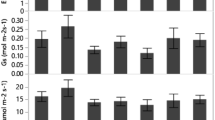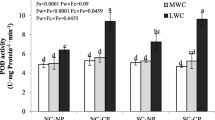Abstract
Seedlings from four provenances of Jatropha curcas were subjected to 80, 50, and 30% of soil field capacity in potted experiments in order to study their responses to water availability. Our results showed that with the decline of soil water availability, plant growth, biomass accumulation, net photosynthetic rate, stomatal conductance (gs), and transpiration rate (E) decreased, whereas leaf carbon isotope composition (δ13C), leaf pigment contents, and stomatal limitation value increased, while maximal quantum yield of PSII photochemistry was not affected. Our findings proved that stomatal limitation to photosynthesis dominated in J. curcas under low water availability. The increase of δ13C should be attributed to the decrease in gs and E under the lowest water supply. J. curcas could adapt to low water availability by adjusting its plant size, stomata closure, reduction of E, increasing δ13C, and leaf pigment contents. Moreover, effects of provenance and the interaction with the watering regime were detected in growth and many physiological parameters. The provenance from xeric habitats showed stronger plasticity in the plant size than that from other provenances under drought. The variations may be used as criteria for variety/provenance selection and improvement of J. curcas performance.
Similar content being viewed by others
Abbreviations
- Ca:
-
ambient chamber CO2 concentration
- Car:
-
carotenoids
- Chl:
-
chlorophyll
- Ci:
-
intercellular CO2 concentration
- E :
-
transpiration rate
- FC:
-
soil field capacity
- FM:
-
fresh mass
- Fv/Fm :
-
maximal quantum yield of PSII photochemistry
- g s :
-
stomatal conductance
- Ls :
-
stomatal limitation value
- P N :
-
net photosynthetic rate
- Rs :
-
root/shoot ratio
- WUE:
-
water-use efficiency
- δ13C:
-
carbon isotope composition
References
Achten W.M.J., Maes W.H., Reubens B. et al.: Biomass production and allocation in Jatropha curcas L. seedlings under different levels of drought stress.–Biomass Bioenerg. 34: 667–676, 2010.
Achten W.M.J., Verchot L., Franken Y.J. et al.: Jatropha biodiesel production and use.–Biomass Bioenerg. 32: 1063–1084, 2008.
Bartholomé J., Mabiala A., Savelli B. et al.: Genetic architecture of carbon isotope composition and growth in Eucalyptus across multiple environments.–New Phytol. 206: 1437–1449, 2015.
Berry J.A., Downton W.J.S.: Environmental regulation of photosynthesis.–In: Govindjee (ed.): Photosynthesis: Development, Carbon Metabolism, and Plant Productivity. Vol. II. Pp. 263–343. Academic Press, New York 1982.
Boyer J.S.: Plant productivity and environment.–Science 218: 443–448, 1982.
Costa J.M., Ortuño M.F., Lopes C.M. et al.: Grapevine varieties exhibiting differences in stomatal response to water deficits.–Funct. Plant Biol. 39: 179–189, 2012.
Díaz-López L., Gimeno V., Simón I. et al.: Jatropha curcas seedlings show a water conservation strategy under drought conditions based on decreasing leaf growth and stomatal conductance.–Agr. Water Manage. 105: 48–56, 2012.
Dichio B., Montanaro G., Sofo A., Xiloyannis C.: Stem and whole-plant hydraulics in olive (Olea europaea) and kiwifruit (Actinidia deliciosa).–Trees-Struct. Funct. 27: 183–191, 2013.
Divakara B.N., Upadhyaya H.D., Wani S.P., Gowda C.L.L.: Biology and genetic improvement of Jatropha curcas L.: a review.–Appl. Energ. 87: 732–742, 2010.
Fairless D.: Biofuel: the little shrub that could-maybe.–Nature 449: 652–655, 2007.
Farquhar G., Richards R.: Isotopic composition of plant carbon correlates with water-use efficiency of wheat genotypes.–Funct. Plant Biol. 11: 539–552, 1984.
Fini A., Bellasio C., Pollastri S. et al.: Water relations, growth, and leaf gas exchange as affected by water stress in Jatropha curcas.–J. Arid Environ. 89: 21–29, 2013.
Galmés J., Medrano H., Flexas J.: Photosynthetic limitations in response to water stress and recovery in Mediterranean plants with different growth forms.–New Phytol. 175: 81–93, 2007.
Inskeep W.P., Bloom P.R.: Extinction coefficients of chlorophyll a and b in N,N-dimethylformamide and 80% acetone.–Plant Physiol. 77: 483–485, 1985.
Jiang H.M., Yang J.C., Zhang J.F.: Effects of external phosphorus on the cell ultrastructure and the chlorophyll content of maize under cadmium and zinc stress.–Environ. Pollut. 147: 750–756, 2007.
Jongschaap R.E.E., Blesgraaf R.A.R., Bogaard T.A. et al.: The water footprint of bioenergy from Jatropha curcas L.–P. Natl. Acad. Sci. USA 106: E92, 2009. doi: 10.1073/pnas.0907272106
Kheira A.A.A., Atta N.M.M.: Response of Jatropha curcas L. to water deficit: Yield, water use efficiency and oilseed characteristics.–Biomass Bioenerg. 33: 1343–1350, 2009.
Kumar A., Sharma S.: An evaluation of multipurpose oil seed crop for industrial uses (Jatropha curcas L.): A review.–Ind. Crop. Prod. 28: 1–10, 2008.
Kumar G., Biswarup S., Lin C.: Pretreatment and hydrolysis methods for recovery of fermentable sugars from de-oiled Jatropha waste.–Bioresource Technol. 145: 275–279, 2013.
Li C., Berninger F., Koskela J., Sonninen E.: Drought responses of Eucalyptus microtheca provenances depend on seasonality of rainfall in their place of origin.–Aust. J. Plant Physiol. 27: 231–238, 2000.
Lichtenthaler H.K., Wellburn A.R.: Determinations of total carotenoids and chlorophylls a and b of leaf extracts in different solvents.–Biochem. Soc. Trans. 11: 591–592, 1983.
Maes W.H., Achten W.M.J., Muys B.: Use of inadequate data and methodological errors lead to an overestimation of the water footprint of Jatropha curcas.–P. Natl. Acad. Sci. USA 106: E91, 2009a. doi: 10.1073/pnas.0906788106
Maes W.H., Achten W.M.J., Reubens B. et al.: Plant-water relationships and growth strategies of Jatropha curcas L. saplings under different levels of drought stress.–J. Arid Environ. 73: 877–884, 2009b.
Maes W.H., Trabucco A., Achten W.M.J., Muys B.: Climatic growing conditions of Jatropha curcas L.–Biomass Bioenerg. 33: 1481–1485, 2009c.
Maxwell K., Johnson G.N.: Chlorophyll fluorescence–a practical guide.–J. Exp. Bot. 51: 659–668, 2000.
Ovando-Medina I., Sánchez-Gutiérrez A., Adriano-Anaya L. et al.: Genetic diversity in Jatropha curcas populations in the state of Chiapas, Mexico.–Diversity 3: 641–659, 2011.
Popluechai S., Breviario D., Mulpuri S. et al.: Narrow genetic and apparent phenetic diversity in Jatropha curcas: initial success with generating low phorbol ester interspecific hybrids.–Nat. Preced. hdl:10101/npre.2009.2782.1, 2009.
Rajaona A.M., Brueck H., Seckinger C., Asch F.: Effect of salinity on canopy water vapor conductance of young and 3-year-old Jatropha curcas L.–J. Arid Environ. 87: 35–41, 2012.
Rao G.R., Korwar G.R., Shanker A.K., Ramkrishna Y.S.: Genetic associations, variability and diversity in seed characters, growth, reproductive phenology and yield in Jatropha curcas (L.) accessions.–Trees-Struct. Funct. 22: 697–709, 2008.
Rosenqvist E., van Kooten O.: Chlorophyll fluorescence: a general description and nomenclature.–In: De Ell J.R., Toivonen P.M.A. (ed.): Practical Applications of Chlorophyll Fluorescence in Plant Biology. Pp. 31–78. Kluwer Acad. Publ., Dordrecht 2003.
Samsuri A., Zoveidavianpoor M.: Does the maturity of Jatropha curcas L. affect the quality and quantity of the yield of oil for biodiesel production?–Int. J. Green Energy 11: 193–205, 2014.
Sapeta H., Costa J.M., Lourenço T. et al.: Drought stress response in Jatropha curcas: Growth and physiology.–Environ. Exp. Bot. 85: 76–84, 2013.
Trabucco A., Achten W.M.J., Bowe C. et al.: Global mapping of Jatropha curcas yield based on response of fitness to present and future climate.–GCB-Bioenergy 2: 139–151, 2010.
Varone L., Ribas-Carbo M., Cardona C. et al.: Stomatal and nonstomatal limitations to photosynthesis in seedlings and saplings of Mediterranean species pre-conditioned and aged in nurseries: Different response to water stress.–Environ. Exp. Bot. 75: 235–247, 2012.
Ye M., Li C., Francis G., Makkar H.P.S.: Current situation and prospects of Jatropha curcas as a multipurpose tree in China.–Agroforest Syst. 76: 487–497, 2009.
Yin C., Pang X., Chen K. et al.: The water adaptability of Jatropha curcas is modulated by soil nitrogen availability.–Biomass Bioenerg. 47: 71–81, 2012.
Yin C., Pang X., Chen K.: The effects of water, nutrient availability and their interaction on the growth, morphology and physiology of two poplar species.–Environ. Exp. Bot. 67: 196–203, 2009a.
Yin C., Pang X., Lei Y.: Populus from high altitude has more efficient protective mechanisms under water stress than from low-altitude habitats: A study in greenhouse for cuttings.–Physiol. Plantarum 137: 22–35, 2009b.
Author information
Authors and Affiliations
Corresponding author
Additional information
Acknowledgments: This research was supported by the National Science and Technology Infrastructure Program (No. 2007 BAD50B01). The authors thank Lee Goldsmith from Iowa State University, Ames, IA, USA, for language improving. We would like to thank Dr. Helena Synková and Ing. Ivana Štetinová for their technical assistance, and anonymous reviewers for their valuable comments.
Rights and permissions
About this article
Cite this article
Yin, C.Y., Pang, X.Y., Peuke, A.D. et al. Growth and photosynthetic responses in Jatropha curcas L. seedlings of different provenances to watering regimes. Photosynthetica 54, 367–373 (2016). https://doi.org/10.1007/s11099-016-0201-2
Received:
Accepted:
Published:
Issue Date:
DOI: https://doi.org/10.1007/s11099-016-0201-2




